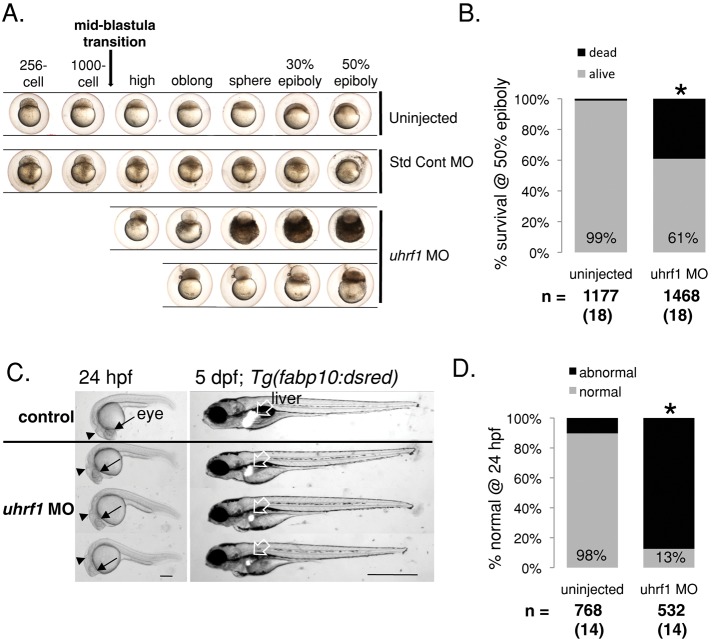The journal wishes to point out that a correction has been made to “UHRF1 phosphorylation by cyclin A2/cyclin-dependent kinase 2 is required for zebrafish embryogenesis” (Mol. Biol. Cell [2012] 23, 59–70; originally published in MBoC In Press as 10.1091/mbc.E11-06-0487). Due to errors by the journal's composition vendor, two of the labels in Figure 4B were published incorrectly. The correct labels are dead (black) and alive (gray); the correct figure is reproduced below.
FIGURE 4:
uhrf1 is essential for zebrafish development. (A) Early embryonic development of uninjected, standard control morpholino-injected, and uhrf1 morpholino-injected embryos. uhrf1 morphants display a distinct developmental arrest phenotype leading to early embryonic death. Scale bar: 500 μm. (B) By 50% epiboly, uhrf1 morphants exhibit decreased survival to 61% compared with 99% of control. Total number of embryos and experiments are noted under each bar. *, p < 0.0001 by Fisher's exact test. (C) Left, uhrf1 morphants at 24 hpf are characterized by a small head, underdeveloped eye (arrow), and abnormal brain, typified by the depressed midbrain–hindbrain boundary (arrowhead) and dilated ventricle (caudal to arrowhead). Scale bar: 100 μm. Right, uhrf1 morphants at 5 dpf have a small liver as visualized in Tg(fabp10:dsred) zebrafish. All morphants have a small liver in three experiments. Scale bar: 500 μm. (D) uhrf1 morphants have a significant abnormal phenotype at 24 hpf. Total number of embryos and experiments are noted under each bar; *, p < 0.0001 by Fisher's exact test.
The HTML and PDF versions were corrected on the Molecular Biology of the Cell website on 8 October 2012. These corrections may not appear on copies of the article that reside on other websites.



